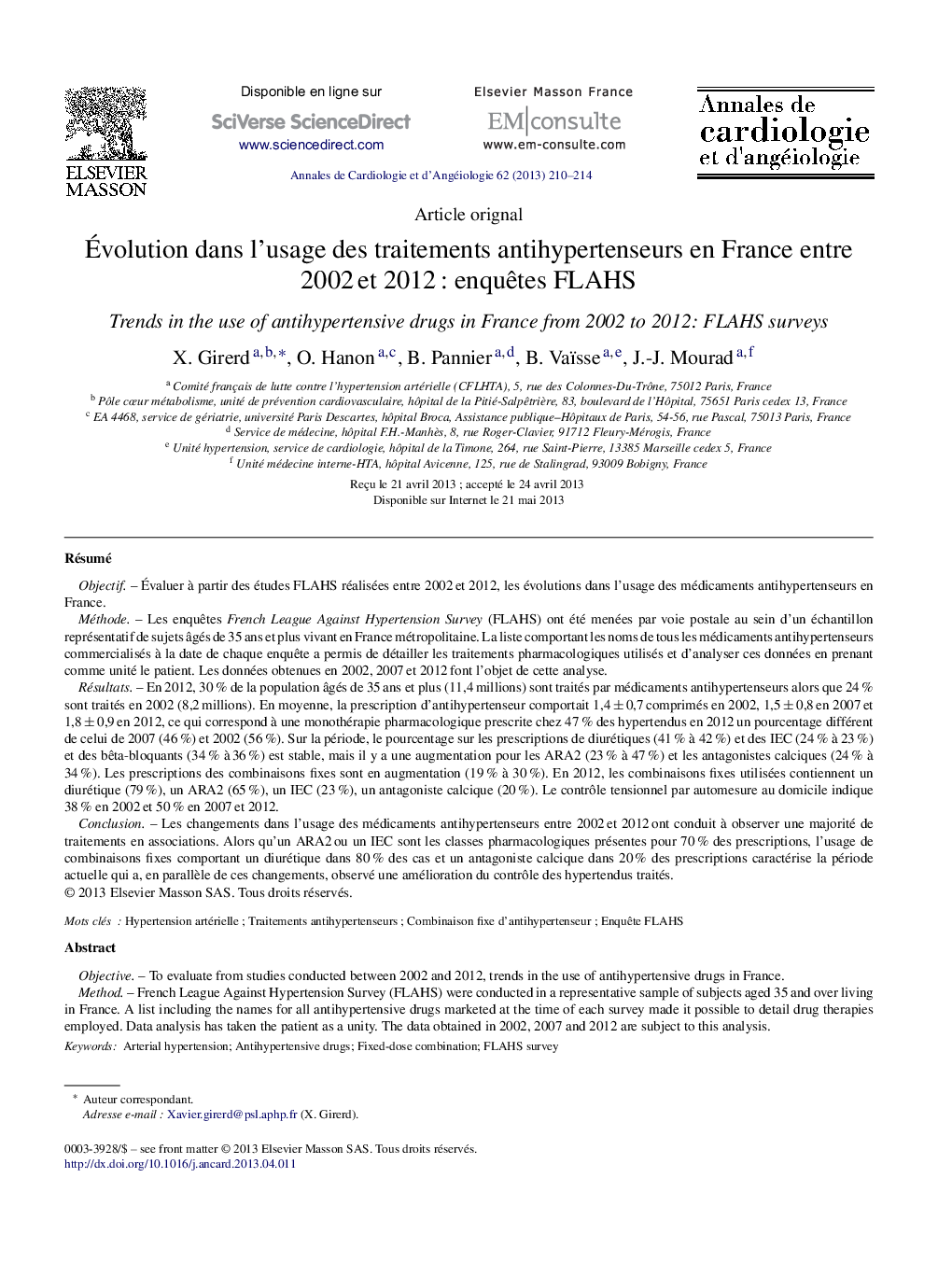| Article ID | Journal | Published Year | Pages | File Type |
|---|---|---|---|---|
| 2869034 | Annales de Cardiologie et d'Angéiologie | 2013 | 5 Pages |
RésuméObjectifÉvaluer à partir des études FLAHS réalisées entre 2002 et 2012, les évolutions dans l’usage des médicaments antihypertenseurs en France.MéthodeLes enquêtes French League Against Hypertension Survey (FLAHS) ont été menées par voie postale au sein d’un échantillon représentatif de sujets âgés de 35 ans et plus vivant en France métropolitaine. La liste comportant les noms de tous les médicaments antihypertenseurs commercialisés à la date de chaque enquête a permis de détailler les traitements pharmacologiques utilisés et d’analyser ces données en prenant comme unité le patient. Les données obtenues en 2002, 2007 et 2012 font l’objet de cette analyse.RésultatsEn 2012, 30 % de la population âgés de 35 ans et plus (11,4 millions) sont traités par médicaments antihypertenseurs alors que 24 % sont traités en 2002 (8,2 millions). En moyenne, la prescription d’antihypertenseur comportait 1,4 ± 0,7 comprimés en 2002, 1,5 ± 0,8 en 2007 et 1,8 ± 0,9 en 2012, ce qui correspond à une monothérapie pharmacologique prescrite chez 47 % des hypertendus en 2012 un pourcentage différent de celui de 2007 (46 %) et 2002 (56 %). Sur la période, le pourcentage sur les prescriptions de diurétiques (41 % à 42 %) et des IEC (24 % à 23 %) et des bêta-bloquants (34 % à 36 %) est stable, mais il y a une augmentation pour les ARA2 (23 % à 47 %) et les antagonistes calciques (24 % à 34 %). Les prescriptions des combinaisons fixes sont en augmentation (19 % à 30 %). En 2012, les combinaisons fixes utilisées contiennent un diurétique (79 %), un ARA2 (65 %), un IEC (23 %), un antagoniste calcique (20 %). Le contrôle tensionnel par automesure au domicile indique 38 % en 2002 et 50 % en 2007 et 2012.ConclusionLes changements dans l’usage des médicaments antihypertenseurs entre 2002 et 2012 ont conduit à observer une majorité de traitements en associations. Alors qu’un ARA2 ou un IEC sont les classes pharmacologiques présentes pour 70 % des prescriptions, l’usage de combinaisons fixes comportant un diurétique dans 80 % des cas et un antagoniste calcique dans 20 % des prescriptions caractérise la période actuelle qui a, en parallèle de ces changements, observé une amélioration du contrôle des hypertendus traités.
ObjectiveTo evaluate from studies conducted between 2002 and 2012, trends in the use of antihypertensive drugs in France.MethodFrench League Against Hypertension Survey (FLAHS) were conducted in a representative sample of subjects aged 35 and over living in France. A list including the names for all antihypertensive drugs marketed at the time of each survey made it possible to detail drug therapies employed. Data analysis has taken the patient as a unity. The data obtained in 2002, 2007 and 2012 are subject to this analysis.ResultsIn 2012, 30% of the French population aged 35 and older was treated with antihypertensive drugs (11.4 million), while 24% were treated in 2002 (8.2 million). On average, prescription of antihypertensive included 1.4 ± 0.7 pills in 2002, 1.5 ± 0.8 in 2007 and 1.8 ± 0.9 in 2012, which corresponds to a pharmacological monotherapy prescribed in 47% of subjects in 2012, a different percentage than in 2007 (46%) and 2002 (56%). Over the period, the percentage of prescriptions of diuretics (41% to 42%) and ACE inhibitors (24% to 23%) and beta-blockers (35% to36%) is stable, but they are increasing with ARBs (23% to 47%) and calcium antagonists (24% to 34%). The prescriptions of fixed-dose combinations were also increased (19% to 30%). In 2012, fixed-dose combinations included a diuretic (79%), an ARB (65%), an ACEI (23%) and a calcium antagonist (20%). Blood pressure control estimated with home blood pressure monitoring increases from 38% in 2002 to 50% in 2007 and 2012.ConclusionChanges in the use of antihypertensive drugs in France between 2002 and 2012 led to the prescription of antihypertensive treatment with associations in the majority. ARBs or ACEI are present on 70% of prescriptions with diuretics combined in 80%. Extensive use of fixed-dose combinations with diuretics and ARA2 characterizes this period in which it was observed an increase in blood pressure control in France.
